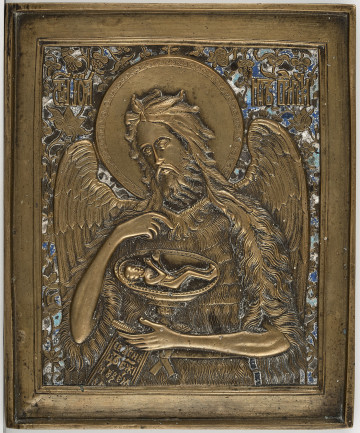
St. John the Baptist
20th century
Castle Museum in Łańcut
Part of the collection: Icons
Crucifixion, silhouette icon. In the first centuries after the resurrection of Christ, when Christian art was emerging, in the East, the word 'icon' was used for any portrayals of Christ, the Mother of God, Apostles, Evangelists, saints, angels, biblical scenes, or symbolic depictions relating to the liturgy. In this sense, the displayed cast of a metal cross with a depiction of the crucified Christ is a silhouette relief icon. The tradition of cast objects of Christian worship originates from Byzantium. Aside from imported ones, products of this type began to be made in Russia at the end of the 11th c., in such centres as Kiev, Veliky Novgorod, Moscow, and over time, throughout the whole of Russia. Crosses belonged to commonly used objects of worship and accompanied Christians from birth do death. In the eastern tradition, Christ's victory over death is emphasised - this is why His figure on the cross is depicted without signs of torment and suffering. The Saviour, with his heat tilted to the right shoulder, in a straight posture, with slightly bent knees, appears to be standing rather than hanging powerlessly on the cross. Christ's widely outstretched arms indicate the willingness to receive the sins of humanity. As a sign of His submission to the will of the Father, the Son's hands are open and their fingers straightened. The separately nailed feet being supported by the lower crossbeam symbolise dignity and majesty. The skull placed beneath the cross symbolises the Tomb of Adam - Christ, as the New Adam, ereased the sin of the First Parents through the power of the blood flowing from His wounds. In the Rus tradition, the eight-pointed cross with three crossbeams became widespread and was more commonly used. In fact, these are two separate crosses overlapping each other, as can be seen in the example of the displayed exhibit (see S.12789MŁ; S.12791- 12792MŁ; S.12794-12795MŁ; S.12869MŁ; S.12871-12876MŁ). Teresa Bagińska-Żurawska https://orcid.org/0000-0002-9243-3967
Dimensions
height: 17.2 cm, width: 9.9 cm
Object type
Icons
Technique
cast
Material
brass
Origin / acquisition method
decyzja administracyjna
Creation time / dating
Creation / finding place
Owner
Castle Museum in Łańcut
Identification number
Location / status

20th century
Castle Museum in Łańcut

19th (?) century
Castle Museum in Łańcut

1800 — 1850
Castle Museum in Łańcut
DISCOVER this TOPIC
National Museum in Lublin
DISCOVER this PATH
Educational path